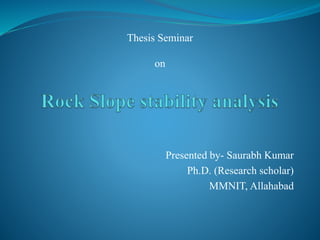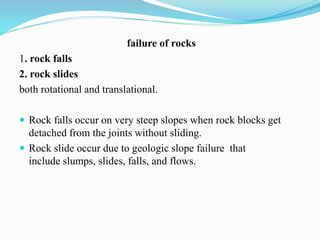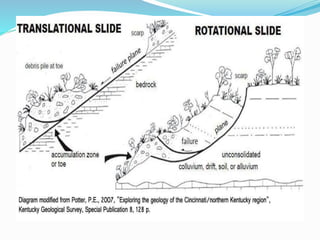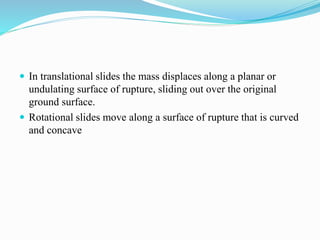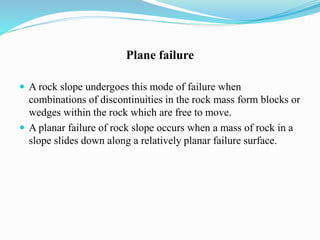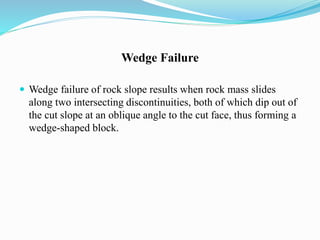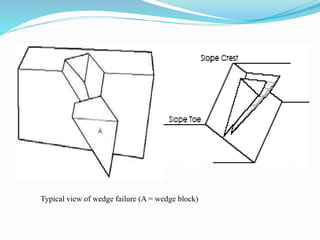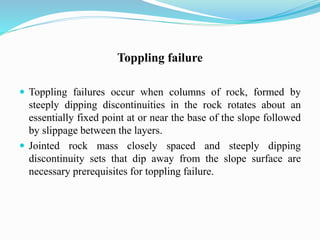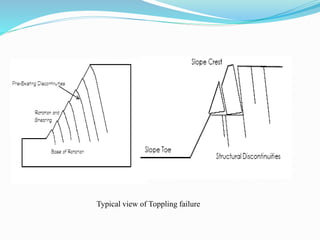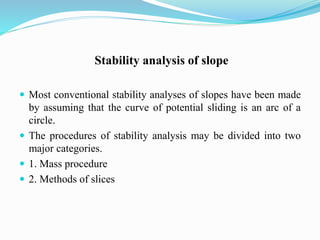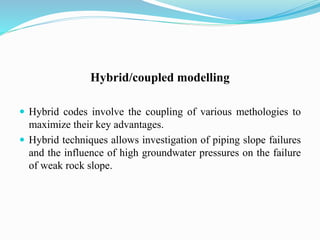Slope stability analysis
- 1. Presented by- Saurabh Kumar Ph.D. (Research scholar) MMNIT, Allahabad Thesis Seminar on
- 2. Slope stability ÔÇó Slope stability is the potential of soil covered slopes to withstand and undergo movement. ÔÇó Stability is determined by the balance of shear stress and shear strength. ÔÇó A stable slope may be initially affected by preparatory factors, making the slope conditionally unstable. ÔÇó The field of slope stability encompasses static and dynamic stability of slopes of earth and rock-fill dams.
- 3. failure of rocks 1. rock falls 2. rock slides both rotational and translational. ÔÇó Rock falls occur on very steep slopes when rock blocks get detached from the joints without sliding. ÔÇó Rock slide occur due to geologic slope failure that include slumps, slides, falls, and flows.
- 4. ÔÇó A rock fall is a fragment of rock (a block) detached by sliding, toppling, or falling, that falls along a vertical or sub-vertical cliff, proceeds down slope by bouncing and flying along ballistic trajectories or by rolling on talus or debris slopes. ÔÇó A rockslide is a type of landslide caused by rock failure in which part of the bedding plane of failure passes through intact rock and material collapses in a group and not in individual blocks.
- 5. Figure shows typical view of rock fall and rockslide
- 7. ÔÇó In translational slides the mass displaces along a planar or undulating surface of rupture, sliding out over the original ground surface. ÔÇó Rotational slides move along a surface of rupture that is curved and concave
- 9. Plane failure ÔÇó A rock slope undergoes this mode of failure when combinations of discontinuities in the rock mass form blocks or wedges within the rock which are free to move. ÔÇó A planar failure of rock slope occurs when a mass of rock in a slope slides down along a relatively planar failure surface.
- 10. Typical view of Plane failure (A = Sliding plane, B = Slope face)
- 11. Wedge Failure ÔÇó Wedge failure of rock slope results when rock mass slides along two intersecting discontinuities, both of which dip out of the cut slope at an oblique angle to the cut face, thus forming a wedge-shaped block.
- 12. Typical view of wedge failure (A = wedge block)
- 13. Circular failure ÔÇó Circular failure is generally observed in slope of soil, mine dump, weak rock and highly jointed rock mass. ÔÇó It is very important to identify the position of most critical circle in analysis of such failure
- 14. Typical view of Circular failure
- 15. Toppling failure ÔÇó Toppling failures occur when columns of rock, formed by steeply dipping discontinuities in the rock rotates about an essentially fixed point at or near the base of the slope followed by slippage between the layers. ÔÇó Jointed rock mass closely spaced and steeply dipping discontinuity sets that dip away from the slope surface are necessary prerequisites for toppling failure.
- 16. Typical view of Toppling failure
- 17. Objectives of rock slope stability analysis ÔÇó To identify the lethological characteristics and their disposition. ÔÇó To find out the geological structure viz folds, fault and joints.
- 18. Stability analysis of slope ÔÇó Most conventional stability analyses of slopes have been made by assuming that the curve of potential sliding is an arc of a circle. ÔÇó The procedures of stability analysis may be divided into two major categories. ÔÇó 1. Mass procedure ÔÇó 2. Methods of slices
- 19. ÔÇó CULMANN METHOD ÔÇó A technique for the calculation of slope stability based upon the assumption of a plane surface of failure through the toe of the slope has been proposed by Cullmann. ÔÇó it has been found that plane surfaces of sliding are observed only with very steep slopes, and for relatively flat slopes the surfaces of sliding are almost always curved.
- 20. Culmann Approach to Slope Stability By above equation s, find the c’ and C’m , Factor of safety with respect to strength
- 21. Failure analysis by slip circle method The shear strength is acting along the length of the sliding arc at moment arm length r. the slope is stable when W1l1 ‚⧠W2l2 +sLr The factor of safety is ùêπùëÇùëÜ= W2l2 +sLr W1l1 Swedish slip circle method
- 22. Ordinary slip circle method ÔÇó In cases where the effective angle of shearing resistance is not constant over the failure surface. ÔÇó In this method, slip surface is divided into a number of vertical strips or slices. ÔÇó The forces between slices are neglected and each slice is assumed to act independently as a column of soil of unit thickness and width.
- 23. Ordinary Method of Slices
- 24. Bishop method of slices ÔÇó the analysis is carried out in terms of stresses instead of forces which were used with the Ordinary Method of Slices. ÔÇó The major difference between the Bishop Method and the Ordinary Method of Slices is that resolution of forces takes place in the vertical direction instead of a direction normal to the arc.
- 25. Factor of safety
- 26. Stresses and Forces Acting on a Typical Slice
- 27. Numerical methods of analysis Numerical modelling techniques provide an approximate solution to problems which otherwise cannot be solved by conventional methods. Example- Complex geometry, material anisotropy, non-linear behavior, in situ stresses etc. ÔÇó Continuum modelling ÔÇó Discontinuum modelling ÔÇó Hybrid/coupled modelling
- 28. Continuum modelling ÔÇó Modelling of the continuum is suitable for the analysis of soil slopes, massive intact rock or heavily jointed rock masses. ÔÇó This approach includes the finite-difference and finite element methods that discretize the whole mass to finite number of elements with the help of generated mesh
- 29. Discontinuum modelling ÔÇó Discontinuum approach is useful for rock slopes controlled by discontinuity behavior. ÔÇó . Rock mass is considered as an aggregation of distinct, interacting blocks subjected to external loads and assumed to undergo motion with time.
- 30. Hybrid/coupled modelling ÔÇó Hybrid codes involve the coupling of various methologies to maximize their key advantages. ÔÇó Hybrid techniques allows investigation of piping slope failures and the influence of high groundwater pressures on the failure of weak rock slope.
- 31. ÔÇó THANK YOU
